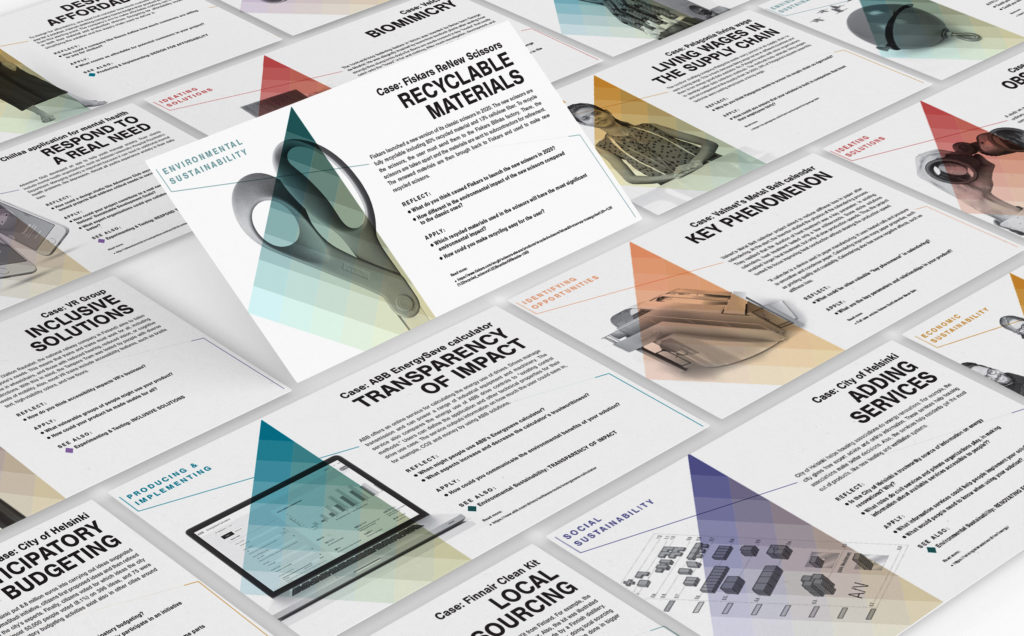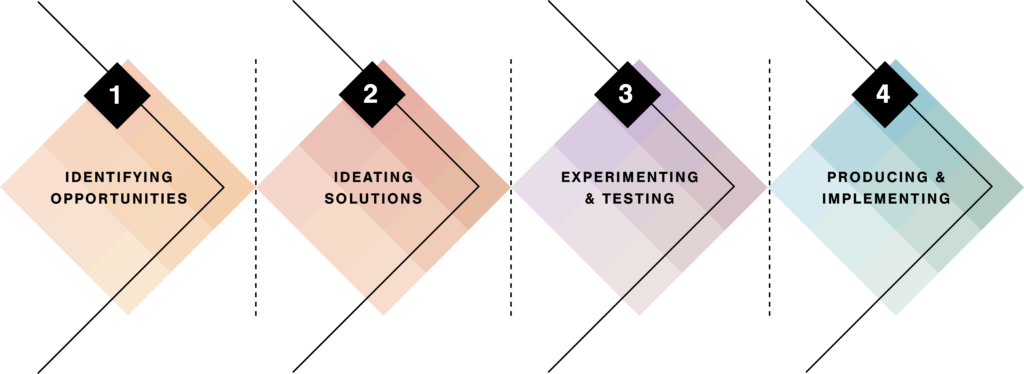LEARN ABOUT
DESIGN & SUSTAINABILITY
with real case examples!
The Design+Sustainability card decks offer case descriptions and prompts to think about sustainability in design with a range of diverse examples to support understanding, learning, and reflection. The cards can be used to support discussing sustainability and integrating core principles in ongoing design processes, both in the classroom and in project work (whether you are a student or a professional).

There are two decks of cards, both feature case examples and prompts:
- From the perspective of sustainability pillars (environmental, economic, and social)
- From the perspective of design phases (identifying opportunities, ideating solutions, experimenting & testing, and producing & implementing)
We also invite you to create your own cards using the modifiable case card layouts (ppt). If you’d like us to add your cards to our decks, send the file to tua.bjorklund(at)aalto.fi – we’ll review your content and add it to the case deck!
For more card-based design tools and info on how to use them, see “Card-based design tools: a review and analysis of 155 card decks for designers and designing” (Roy and Warren 2019).
SUSTAINABILITY PILLARS
The D+Sustainability card deck (pdf) explores a range of sustainability considerations building on the three pillars of social, environmental and economic development ‒ or in more popular terms, the triple bottom line of people, planet and prosperity (profit). These range from renovating for energy efficiency to considering living wages in the supply chain. Each card in the deck is connected to a particular sustainability pillar.

Environmental
For maintaining biological diversity and preserving biological ecosystems, e.g.
- Life cycle thinking
- Renewable material options
- Circular solutions
- Energy reduction
- Optimised manufacturing
Economic
For achieving business goals without damaging the environment or diminishing social equity and justice, e.g.
- Viable business models
- Value of offerings
- Accessibility & reach of offerings
- Resilient ecosystems
Social
For meeting basic human needs as well as promoting equity, justice, and diversity, e.g.
- Food & hygiene
- Accessibility
- Inclusiveness
- Addressing vulnerable people
HOW TO USE THIS DECK?
A few example use cases to get you started…
Learning from case studies
- Each student gets a card, or selects one that resonates with them.
- Students do research to respond to the ‘reflect’ and ‘apply’ prompt questions.
- Students share their findings, focusing on surprising or interesting insights.
Brainstorming with sustainability prompts
- Create clarity around the design challenge, or problem to be solved
- Randomly show one card from the card deck, and generate simple ideas on how to apply the core principle of this card to your design challenge
- After a few minutes, show another card, and generate more ideas
- Work through 5-10 cards, or until a large mass of ideas is on the table
- Cluster these to inspire your next steps
Researching with sustainability prompts
- Each team member gets one card and reviews the case, deepening their understanding with the ‘reflect’ prompt and additional resources
- Individually, brainstorm ways this case could work as a good example or inspiration for your design challenge
- Share with the team and identify interesting elements to take forward or explore further
DESIGN PHASES
This Design+S card deck (pdf) explores a range of sustainability decisions made throughout the design process. These range from including a broader range of stakeholders when making sense of a challenge to using different types of prototyping methods when testing ideas. Each card in the deck is connected to a particular design phase.
You can also review the longer Valmet Metal Belt Calendar (pdf) case article for inspiration on how to turn a case study into a series of case cards – or if you’re curious to see one more detailed example of sustainable design in action!

1. Identifying Opportunities
For figuring out what is relevant and valuable to design, as well as for searching new points of view.
2. Ideating Solutions
For systematically generating potential solutions.
3. Experimenting & Testing
For honing your solutions through experiments and tests.
4. Producing & Implementing
For building realistic models of your solutions and finding the right production methods.
HOW TO USE THIS DECK?
A few example use cases to get you started…
Introducing sustainability pillars
- Each student gets a card, or selects one that resonates with them.
- Students form pairs and discuss how sustainability is present in their cards, or how effective they believe the case examples are in supporting a more sustainable future.
- After the pair discussions, introduce the three pillars of sustainability and how they might overlap or interconnect.
Learning from case studies
- Each student gets a card, or selects one that resonates with them.
- Students do research to respond to the ‘reflect’ and ‘apply’ prompt questions.
- Students share their findings, focusing on surprising or interesting insights.
Researching with case prompts
- Each team member gets one card and reviews the case, deepening their understanding with the ‘reflect’ prompt and additional resources
- Individually, brainstorm ways this case could work as a good example or inspiration for your design challenge
- Share with the team and identify interesting elements to take forward or explore further
Improving design practice
- Take a card corresponding to the phase you are currently in with your project team
- Collectively, review the case and establish sufficient understanding using the ‘Reflect’ prompts
- Individually, brainstorm ideas how you might be able to adopt the core principle in your design practice
- Share your ideas and decide on what might be worth exploring further as a team
 Aalto DF
Aalto DF